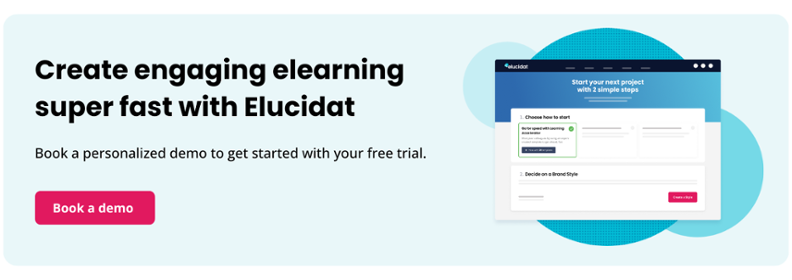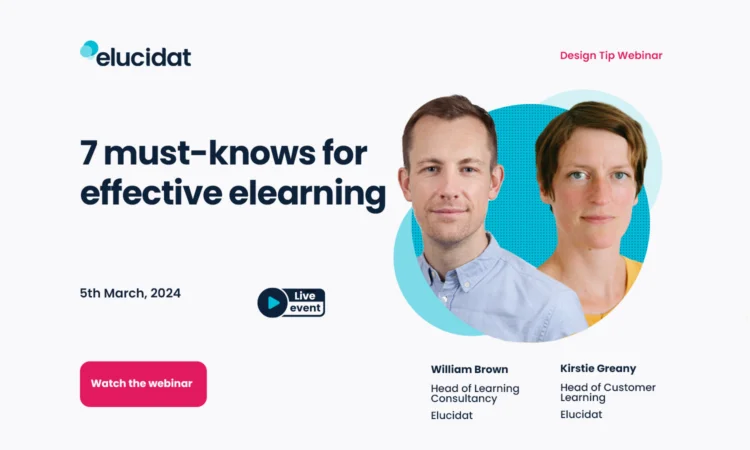Bite-sized learning guide: tips, benefits & importance
7 minute read

Bite-sized elearning modules are small, self-contained information nuggets. They typically range in duration from 1 to 15 minutes and are usually focused on one or two tightly defined learning objectives. Here are a few examples. In contrast, more conventional elearning modules can take between 30 and 60 minutes (or longer) to consume and have a wider range of objectives.
Bite-sized elearning is gaining popularity. Our analysis of over 65,000 pieces of digital learning in Elucidat reveals an average session time of 15 minutes, which is actually a relatively long time, given these modern averages.
What is bite-sized learning?
Bite-sized learning is as simple as it sounds: breaking down elearning content into digestible chunks, which is easier for learners to work through at a pace that suits them. Also known as microlearning, it makes it much easier for learners to fit into their busy schedules.
It’s considered to be the modern way of learning, which is both effective and engaging. But what are the benefits of bite-sized learning?
Here are a few examples of how businesses and employees can benefit from bite-sized learning.
- Increases learner retention – Learners are more likely to remember information when it is presented in small, consumable chunks.
- Suitable for refresher training – Delivering smaller nuggets of information is a useful and efficient way to respond to evolving business environments when a full training course isn’t suitable.
- Improved employee engagement – Bite-sized learning increases employee engagement, as it suits the content consumption habits of modern learners. It enables learners to guide themselves through the training materials at their own pace.
- Provides transferable insights – Micro-content supplies job-specific knowledge that learners can apply to their roles straight away. It gives learners the information they need to put into practice.
In addition to general learner preference for bite-sized learning, here are three great reasons why you should consider adopting it.
1. It takes less time to consume and is more flexible
Employers are increasingly squeezing training into gaps in employees’ schedules, rather than allocating extended blocks of study time. Elearning pieces that are designed to be meaningful in a short session (10-15 minutes) fit more easily into this model.
Available just-in-time
Bite-sized nuggets also tend to be better than larger modules for just-in-time support. For example, if an employee needs a refresher on a seldom-used software feature, they probably want it immediately. In this case it’s more meaningful and convenient for the employee to watch a simple 2-minute video on that particular feature, rather than wading through a 60-minute module that covers all of the software features.
Use flexibly
Bite-sized nuggets can be combined and consumed in flexible ways. For example, one learner can access nuggets A, C and D, and another can access C, B and A, depending on their preferences and immediate needs. Learners only have to work through the topics (nuggets) that are meaningful to them, and access them in an order that meets their needs.
Related: See lots of examples of bite-sized learning on our Showcase
2. Shorter sessions suit modern learners
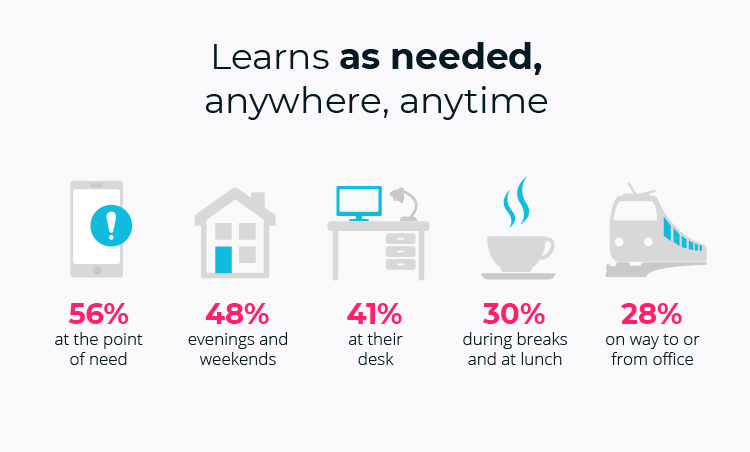
Our profile of a modern learner reports that workplace learners are keen to consume highly relevant and personalized content, which can be consumed on any device of their choice. More often than not, this is on the fly – 56% of modern learners learn at a point of need, and 28% on their commute to and from work.
But reports from Bersin at Deloitte state that the biggest barrier to learning at work is time.
Whilst we know that true learning takes effort, energy and dedication, many learners struggle to find those windows of concentration. Learning broken into short, bite-sized chunks at least has a higher chance of being used.
Interesting work by Dr. Paul Kelley has shown that intense 20-minute bursts of study, separated by 10-minute breaks, can yield better long-term memory retention than longer, continuous periods of study. This mirrors the evidence found by Peter Brown and Co in Make it Stick.
3. Demand for mobile learning is growing
We know that mobile learning is becoming more important as devices become more powerful and more pervasive in the workplace.
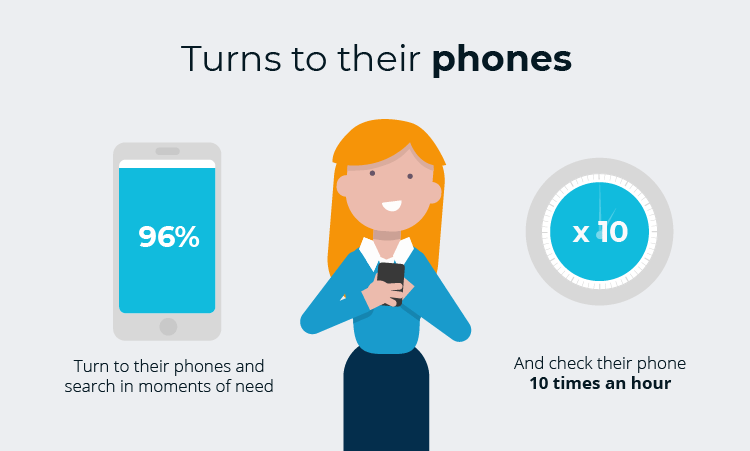
Imagine the difficulty of concentrating on a mobile-based lesson for 40 minutes whilst being jostled on the morning commuter train. The obvious solution is to break modules into smaller, more meaningful chunks.
But that doesn’t mean the nuggets can’t tackle sophisticated issues or be absorbing. To Lie or Not To Lie is an excellent example of an Open University bite-sized nugget that tackles a deep subject in an engaging way. This would only take a learner around 15 minutes to complete, and it is responsive — that is, it adapts and renders well on desktop, tablet and smartphone screens.
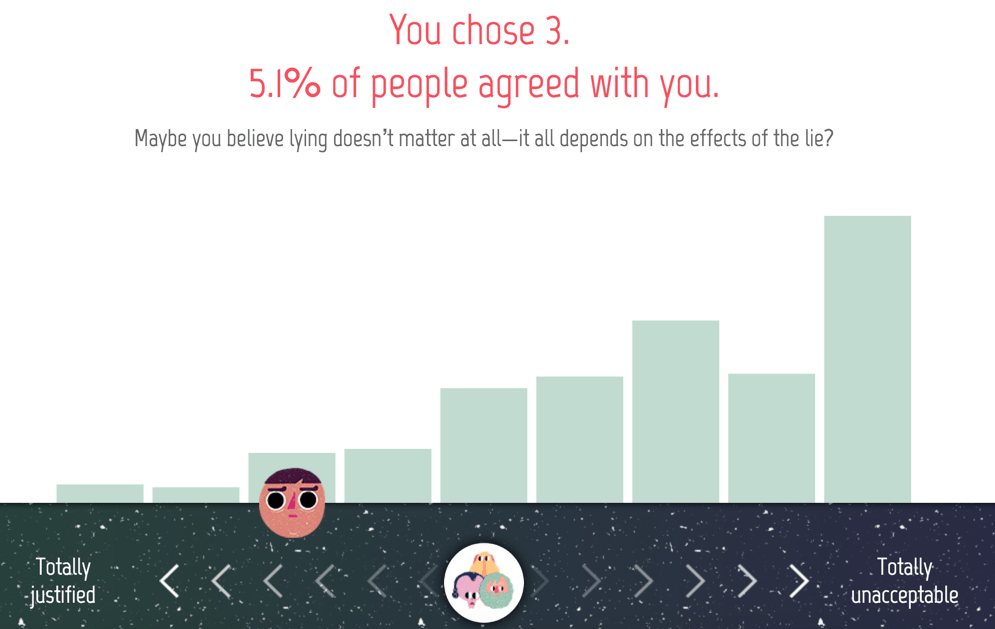
Related: Mobile learning design strategy: Why it matters and how to get the best results for your learners
Our top 5 tips for bite-sized learning
Now you know why you should invest in bite-sized learning, here are our top five tips on how you can create effective microlearning materials.
1. One subject at a time
Bite-sized learning means that you have a narrow time slot in which to deliver the information, so you have to decide what subject matter is specific to the learners’ requirements. It’s important to stick to one subject matter at a time and focus on the key takeaways learners are required to know. Get your subject matter expert (SME) to outline what information is vital and should be the key focus of the micro-content. Concentrate on setting as few objectives as possible to avoid getting bogged down with excessive and unnecessary information.2. Increase retentions with a recap
2. Increase retentions with a recap
Although bite-sized learning is an effective elearning method, there is no clear way of gauging just how much your learners know. Incorporating recaps into bite-sized modules can help assess their proficiency, but remember, it needs to be bite-sized as well! A simple 2-minute test to stimulate and determine their skills will identify learners’ strengths and weaknesses, allowing them to get help with the task.3. Remedy performance gaps
3. Remedy performance gaps
Perhaps the most significant benefit of bite-sized learning is the ability to provide learners with the knowledge they need most. Think about the type of micro-content you create and how it will stimulate learners to focus on specific work-related tasks. In some instances, a simple presentation would do the trick, or perhaps learners would find a game more beneficial depending on the subject matter.
Find out where your learners’ performance gaps are and how you can tailor your micro-content to address their needs. Which skills or tasks do they use on a regular basis? What skills or tasks are they rarely exposed to?4. Provide a support system of additional resources
4. Provide a support system of additional resources
Bite-sized learning doesn’t mean that your learners shouldn’t benefit from a full-scale learning experience. Ensure that your learners have access to other content formats, which can support various microlearning styles. Give learners the flexibility to access longer-form content or video content to expand their knowledge and skills. It’s important to make sure there are other microlearning formats available to supplement the bite-sized learning experience to cater for different learning styles, and also to keep learners engaged throughout.5. Create a bite-sized learning roadmap
5. Create a bite-sized learning roadmap
If you have a large subject area that requires a lot of bite-sized modules and additional supporting content, it can be extremely difficult to keep track of everything. And if you can’t find everything, then your learners sure won’t be able to either.
Implementing a roadmap that organizes all of the bite-sized learning materials will enable learners to easily track their progress, highlighting the modules that are complete and those that are yet to be tackled. It gives learners the freedom to choose what modules they would like to work through next based upon their individual needs. You could even think about creating a personalized bite-sized learning roadmap for each learner.
How can Elucidat help achieve your bite-sized learning goals?
Whether you’re looking to create an effective bite-sized learning experience or require help with your micro-content strategy, Elucidat can help you get the best results from your microlearning content. For some best practice tips see our webpage and free guide.
Our Elucidat experts are on hand to help you produce engaging bite-sized elearning to complement your general learning strategy.

In conclusion
The three arguments for bite-sized learning presented here are very compelling from a learner’s point of view. But as a training provider, the good news is that learning nuggets are also quicker to produce and easier to maintain than larger modules! For some best practice tips see our webpage and free guide.
Find out how Elucidat can help you produce effective bite-sized elearning to work with your microlearning or general learning strategy.
